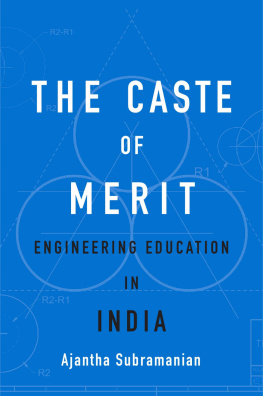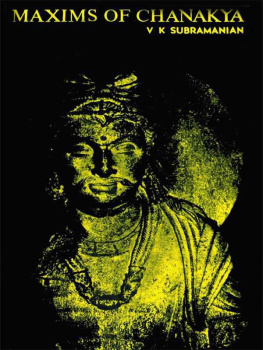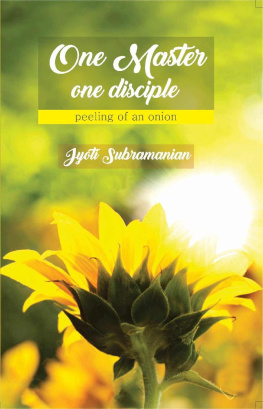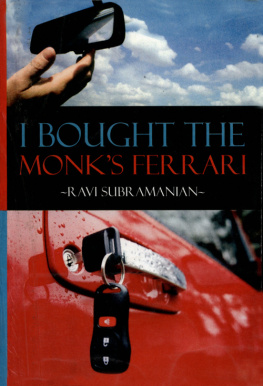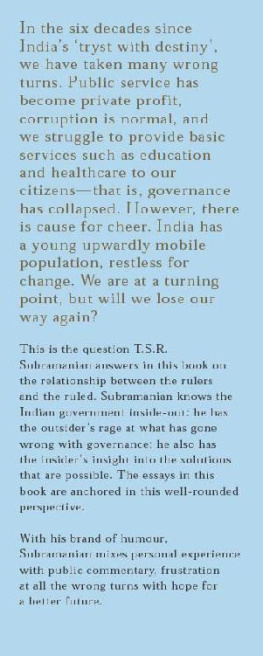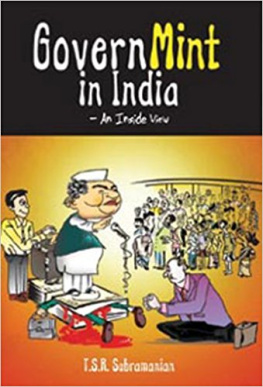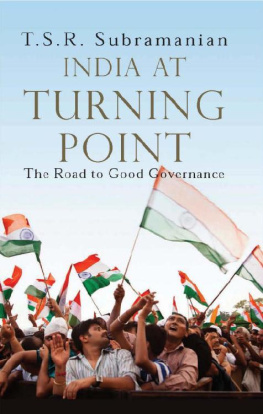Ajantha Subramanian - The Caste of Merit
Here you can read online Ajantha Subramanian - The Caste of Merit full text of the book (entire story) in english for free. Download pdf and epub, get meaning, cover and reviews about this ebook. year: 2019, publisher: Harvard University Press, genre: Politics. Description of the work, (preface) as well as reviews are available. Best literature library LitArk.com created for fans of good reading and offers a wide selection of genres:
Romance novel
Science fiction
Adventure
Detective
Science
History
Home and family
Prose
Art
Politics
Computer
Non-fiction
Religion
Business
Children
Humor
Choose a favorite category and find really read worthwhile books. Enjoy immersion in the world of imagination, feel the emotions of the characters or learn something new for yourself, make an fascinating discovery.
- Book:The Caste of Merit
- Author:
- Publisher:Harvard University Press
- Genre:
- Year:2019
- Rating:5 / 5
- Favourites:Add to favourites
- Your mark:
- 100
- 1
- 2
- 3
- 4
- 5
The Caste of Merit: summary, description and annotation
We offer to read an annotation, description, summary or preface (depends on what the author of the book "The Caste of Merit" wrote himself). If you haven't found the necessary information about the book — write in the comments, we will try to find it.
The Caste of Merit — read online for free the complete book (whole text) full work
Below is the text of the book, divided by pages. System saving the place of the last page read, allows you to conveniently read the book "The Caste of Merit" online for free, without having to search again every time where you left off. Put a bookmark, and you can go to the page where you finished reading at any time.
Font size:
Interval:
Bookmark:
The Caste of Merit
ENGINEERING EDUCATION IN INDIA
Ajantha Subramanian

Cambridge, Massachusetts
London, England
2019
Copyright 2019 by Ajantha Subramanian
All rights reserved
Jacket design: Graciela Galup
Jacket art: Getty Images
978-0-674-98788-3 (alk. paper)
978-0-674-24348-4 (EPUB)
978-0-674-24349-1 (MOBI)
978-0-674-24347-7 (PDF)
The Library of Congress has cataloged the printed edition as follows:
Names: Subramanian, Ajantha, 1969 author.
Title: The caste of merit : engineering education in India / Ajantha Subramanian.
Description: Cambridge, Massachusetts : Harvard University Press, 2019. | Includes bibliographical references and index.
Identifiers: LCCN 2019005718
Subjects: LCSH: Indian Institute of Technology (Chennai, India) | CasteIndia. | Caste-based discriminationIndia. | Discrimination in educationIndia. | Educational equalizationIndia.
Classification: LCC HT720 .S823 2019 | DDC 305.5 / 1220954dc23
LC record available at https://lccn.loc.gov/2019005718
For my parents, V. Vasanthi Devi and K. S. Subramanian
IN A 2003 EPISODE of the CBS television news show 60 Minutes, anchor Leslie Stahl called the attention of Americans to a diasporic population in their midst. What is Americas most valuable import from India? she asked rhetorically. It may very well be brainpower. Hundreds of thousands of well-educated Indians have come to the U.S. in recent decadesmany to work in the computer and software industries. Stahl then specified further: The best and brainiest among them seem to share a common credential: Theyre graduates of the Indian Institute of Technology, better known as IIT.
That same year, Stahls laudatory assessment of the IIT system was echoed in more sardonic terms by Scott Adams, creator of the comic strip Dilbert. In a September 15 strip, its Indian character, Asok, announced that as a graduate of an IIT, he was mentally superior to most people on Earth. The following day, Asok elaborated, At the India [sic] Institute of Technology, I learned to use my huge brain. But I try not to frighten ordinary people with any gratuitous displays of mental superiority. For example, I no longer reheat my tea by holding it to my forehead and imagining fire. With this blend of new and old racial stereotypes of the mystical Indian, the IIT was brought more firmly into American popular consciousness.
Stahls and Adamss early twenty-first-century glorification of Indian technical knowledge contrasts sharply with attitudes in the late colonial period. In nineteenth-century British India, the colonial government expressed a clear preference for engineers from England whose minds were deemed unfettered by the bonds of tradition. Officials overseeing the establishment of the engineering services repeatedly lauded the technical prowess of Europeans, at times treating technical knowledge as a form of racial property. A century later, the racial stereotypes associated with Indian technical knowledge have been inverted: from natives needing to be schooled in the ways of the modern machine, Indians are now invested with an innate capacity for technical knowledge.
Over the nineteenth and twentieth centuries, India witnessed another significant change. Technical knowledge went from being the purview of Indian lower-caste artisans to becoming integral to state power, economic development, and upper-caste status. This process was intimately linked to the rise of engineering. As technological modernization became the emblem of state prowess and societal progress, engineering emerged as a white-collar profession tied to the public display of modern power. In India, the growth of engineering education sidelined lower castes and conscripted upper castes with no prior technical skill into the ranks of a new profession. With the postcolonial states fuller embrace of technologically driven development, the divergence between artisanship and engineering was further consolidated, as was the association between technical knowledge and upper-caste status.
The Caste of Merit chronicles the rise of engineering education in India in the context of older forms of social and economic stratification. More specifically, it illuminates the relationship between engineering education and caste formation. At the heart of the study are the Indian Institutes of Technology. Through a historical anthropology of Indian engineering education, the book tracks how the IITs and their predominantly upper-caste graduates came to be seen as global exemplars of Indian technical knowledge.
A key dimension of this story is the complex relationship between caste and merit. At first glance, the two terms appear antithetical. Caste is the social institution most emblematic of ascriptive hierarchy, while meritocracy is typically understood as a democratizing force that levels inherited privileges and disadvantages. When one looks at the uppermost echelon of higher educational institutions in India, however, caste and merit appear far more proximate, even intimate. Seventy-odd years after independence, the institutional spaces most identified as meritocratic, like the IITs, continue to be overwhelmingly upper caste in composition. Moreover, attempts at opening up these spaces to lower castes through affirmative action and other democratizing measures are consistently met with fervent opposition, not in the name of caste but in the name of preserving merit. Part of my concern, then, is to understand how the democratic ideal of meritocracy services the reproduction of inequality. I analyze the interplay of ascription and achievement through which the collective inheritances of caste have become emblematic of individual merit. In doing so, I argue that social stratification is endemic and not anomalous to contemporary democracy.
The intimacy between caste and merit throws into question the widespread assumption that identitarianism is principally a politics of the marginalized. In the Indian context, this assumption is reflected in arguments about caste as a more salient basis of social distinction and self-definition for lower than for upper castes. More specifically, upper-caste urban professionals are thought to have transcended caste to adopt more modern forms of identification; thus, they are assumed to be casteless by virtue of their modernity. In part, this is because since the 1970s, media and scholarly attention has been far more focused on how lower-caste mobilization has transformed the contours of Indian society and politics. While attention to lower-caste politics has illuminated the transformative potential of subaltern agency, it has also produced an equation between caste politics and subaltern identitarianism. As a result, the proliferation of writing on lower castes that points to caste as a sociopolitical category operating through various registers and at different scales has not led to similarly robust engagement with upper-caste self-definition and maneuver. This is where my work comes in. I look at the role of engineering education, and the IITs in particular, in producing newly consolidated forms of upper-caste affiliation. The leveraging of merit, I argue, must be seen as an expression of upper-caste identitarianism that attempts to forestall progress toward a more egalitarian society and derives its legitimacy from a larger global politics of ascription.
While this book considers the IIT system as a whole, I focus my institutional ethnography on the study of one IITIIT Madras, located in Chennai, the capital city of the southeastern state of Tamilnadu. Tamilnadu is a particularly illuminating context in which to look at the making of upper-caste identity because its history of caste rights politicsin particular, the Non-Brahmin and Dravidian movementscomplicated the naturalization of merit and the transformation of upper castes into casteless moderns. Here, as in other regions with strong traditions of lower-caste rights, merit has long been understood as a product of historical privilege and not simply of innate ability. Moreover, Tamilnadu is the first postindependence state where upper castes challenged measures to democratize access to higher education in the name of both their caste nature and their merit. In this sense, Tamilnadu calls into question castelessness as a stable structure of postindependence upper-caste subjectivity.
Font size:
Interval:
Bookmark:
Similar books «The Caste of Merit»
Look at similar books to The Caste of Merit. We have selected literature similar in name and meaning in the hope of providing readers with more options to find new, interesting, not yet read works.
Discussion, reviews of the book The Caste of Merit and just readers' own opinions. Leave your comments, write what you think about the work, its meaning or the main characters. Specify what exactly you liked and what you didn't like, and why you think so.

